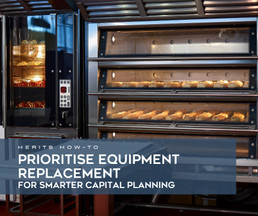31st Oct 2025
How to prioritise equipment replacement for smarter capital planning
Every piece of equipment in a commercial kitchen tells a story. Some earn their place every single day, others struggle to keep up. Deciding which items to replace, refurbish or keep running can make the difference between smooth service and unexpected downtime. For most food business owners, that decision isn’t only about performance, it’s about capital planning, sustainability, and the long-term health of the business.
At Herits, we believe that investing in new or refurbished catering equipment shouldn’t come down to guesswork. It should be guided by structured evaluation, data, and experience. When you measure the right factors, you can see exactly which machines deserve your attention first and where every pound will deliver the most return.
Why every decision counts
Commercial kitchen equipment represents a major share of any hospitality or food production budget. The temptation is often to replace what breaks first, but that can lead to unbalanced investment and hidden costs. A structured assessment of your ‘fleet’, from ovens and mixers to refrigeration and dishwashers, brings clarity. It turns routine purchasing into a strategic process that strengthens reliability, safety and profitability.
A clear evaluation also helps align your team. Chefs, maintenance leads and operations managers all see equipment through different lenses. When those insights are combined in a single review, the results are far more accurate and actionable.
Start with measurable criteria
The most effective equipment evaluations look beyond age or brand. They consider how each unit performs, how much it costs to run, and how easily it can be supported or upgraded.
These are the key factors to measure:
Capacity and demand
Does the equipment meet current and projected production levels? Undersized machines can limit growth, while oversized units waste energy and space.
Reliability and downtime
How often does it fail or require repair? Even short periods of downtime can cause significant financial loss during busy service hours.
Maintenance and cleaning
Easy-to-clean and easy-to-service machines reduce labour and extend lifespan.
Running cost and energy use
Efficiency directly affects your bottom line. Benchmark your utility use per unit against current A-rated models.
Compliance and safety
Equipment must meet all UK safety and hygiene standards. If older models can’t be brought up to code, replacement should move up the priority list.
Parts availability
When spare parts become scarce or costly, long-term maintenance becomes impractical.
Suitability for refurbishment
Some machines can be restored to as-new performance, offering the benefits of sustainability and cost saving without a full replacement.
Impact on workflow
A single outdated or unreliable machine can slow the entire kitchen. Prioritise changes that relieve these bottlenecks.
Resale or trade-in value
Equipment that still holds residual value can offset part of the upgrade cost.
Lead time and installation requirements
Availability and fit-out constraints should influence when replacements are scheduled.
By evaluating each machine against these criteria, you can create a performance profile that reveals both weak spots and hidden opportunities.
Creating a priority plan
Once your equipment is evaluated, the next step is to group items into three priority levels:
Immediate action
Equipment that fails safety checks, can’t meet demand, or poses operational risks.
Medium-term upgrade
Items that are serviceable but inefficient, expensive to run, or approaching the end of their expected lifespan.
Long-term review
Reliable, compliant units that still perform well but should be monitored for signs of decline.
This approach helps business owners avoid reactive spending. Instead of waiting for a breakdown, you can plan ahead, spreading costs over the year and negotiating better deals with suppliers. It also creates a foundation for capital expenditure forecasts, making budgeting more predictable and less stressful.
Balancing new and refurbished options
With each high-priority item identified, the next question is whether to buy new or refurbished. Both have their advantages.
New equipment offers the latest energy-saving features and warranties, ideal for critical operations where uptime cannot be compromised. Refurbished equipment, on the other hand, delivers exceptional value for money. High-quality reconditioned machines perform to professional standards, often at half the cost of new. For many businesses, a combination of both delivers the best outcome, new where innovation adds value, refurbished where durability is critical.
The goal is not just to replace equipment, but to optimise the entire kitchen ecosystem. Every replacement should strengthen efficiency, reduce environmental impact, and make daily operations smoother.
Turning data into action
An evaluation exercise is only useful if it leads to decisions. Use your results to create a clear action plan that includes:
Budget allocation
Assign funds based on urgency and potential return.
Timeline planning
Schedule replacements to minimise service disruption.
Supplier comparison
Use your criteria to assess competing quotes with objectivity.
Environmental reporting
Track your sustainability gains from choosing refurbished or energy-efficient options.
This plan becomes your roadmap for capital investment; one that you can review annually to track improvements and identify emerging risks.
Why this approach works
Structured evaluation shifts equipment management from reactive to proactive. It prevents sudden failures, improves financial planning, and builds a data-driven record of your assets. It also empowers your team to speak with confidence when requesting budget approvals or discussing replacement options with suppliers.
At Herits, we’ve seen how this simple method transforms the way kitchens invest. Instead of rushing to fix what breaks, our clients make deliberate, informed choices that protect their performance for years to come.
Herits helps business owners make confident, data-led decisions about commercial kitchen equipment.
Explore guides, checklists and tools designed to simplify your next upgrade at www.herits.co.uk

